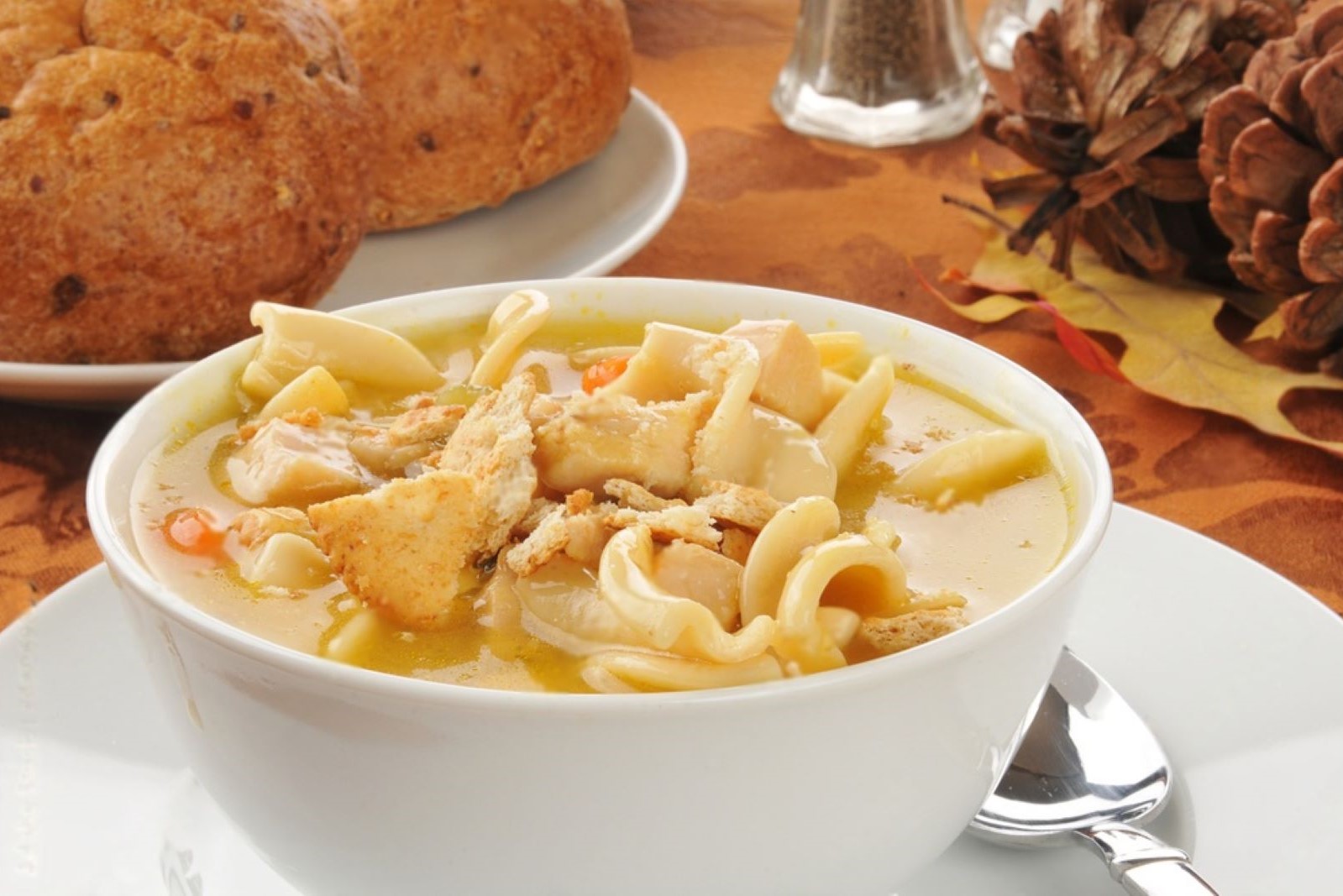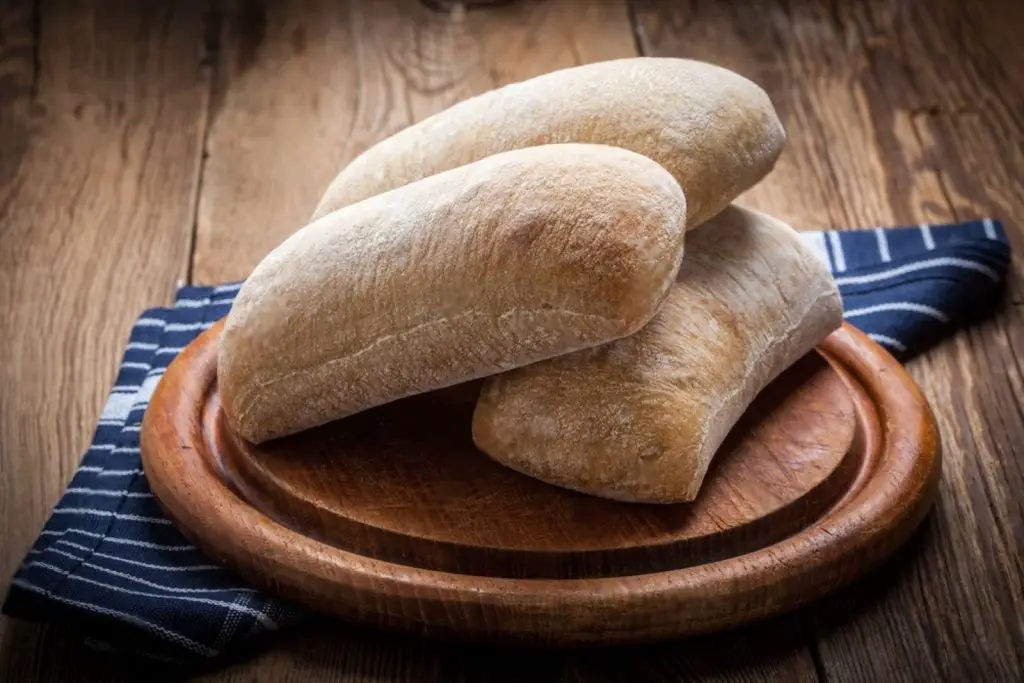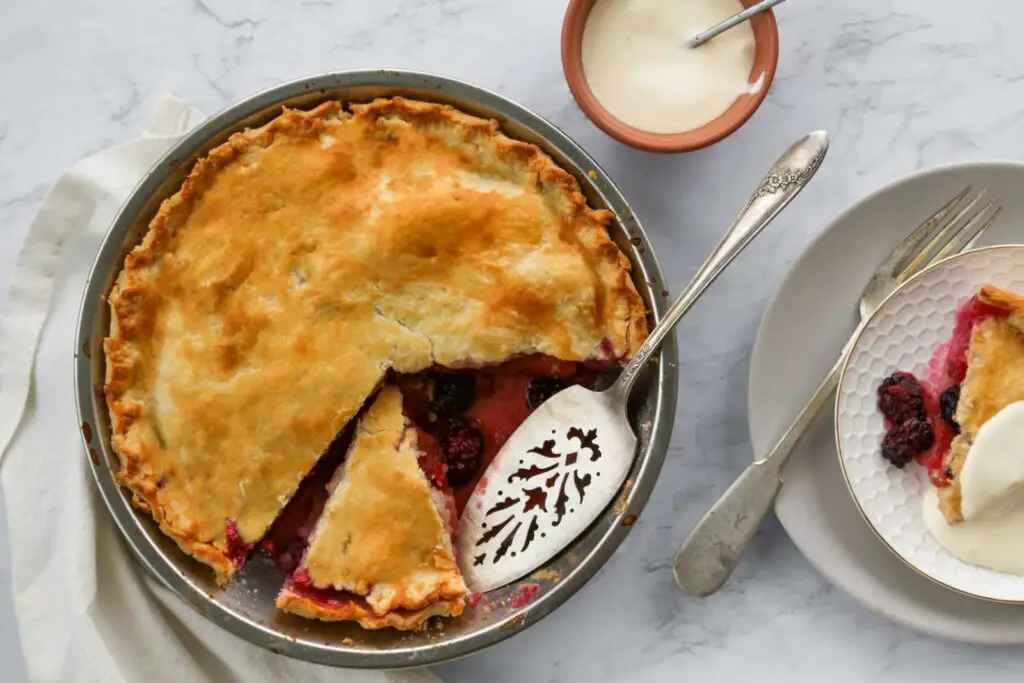
Turkey noodle soup, a soothing and nourishing classic, brings comfort and warmth to the table with every spoonful. Crafted from tender turkey meat, aromatic vegetables, and delicate noodles, this wholesome soup captures the essence of homestyle cooking and the nurturing qualities of a hearty broth. Whether enjoyed as a hearty meal or as a remedy for chilly days, turkey noodle soup carries a sense of tradition and care in every bowl. However, when preparing a large batch of turkey noodle soup or when making it from scratch, it might be challenging to consume it all before it loses its freshness or taste.
Freezing turkey noodle soup becomes a practical and efficient method to preserve its delightful flavors and nourishing properties, ensuring that each ladleful retains its homely goodness and culinary charm, ready to elevate your meals with the essence of perfectly frozen turkey noodle soup, even when a freshly cooked pot isn’t readily available or when you crave the comforting embrace of this homemade classic at your convenience. In this guide, we will delve into the best practices for freezing turkey noodle soup, enabling you to savor the richness of this comforting dish and elevate your culinary creations with the essence of perfectly frozen turkey noodle soup, without the need for continuous homemade preparations or frequent kitchen endeavors.
Here are the simple steps to freeze turkey noodle soup:
Step 1: Prepare and Cook the Soup
When it comes to freezing turkey noodle soup, the first and most crucial step is to prepare and cook the soup itself. This step sets the foundation for the flavor, quality, and overall experience of the dish when you decide to thaw and reheat it later. Here’s a detailed explanation of this initial step:
- Cooking Process: Cooking a batch of turkey noodle soup involves a combination of ingredients and flavors that come together to create a delicious and wholesome dish. The key components include cooked turkey, aromatic vegetables, a flavorful broth, and your preferred type of noodles.
- Cooked Turkey: Make use of leftover cooked turkey, whether it’s from a roast turkey you made earlier or from store-bought options. The turkey provides the main protein element of the soup and contributes to its heartiness and taste.
- Aromatic Vegetables: Choose a selection of aromatic vegetables to enhance the flavor profile of the soup. Common choices include onions, carrots, celery, and garlic. These vegetables add depth and complexity to the broth while infusing it with a delightful aroma.
- Flavorful Broth: The broth forms the base of the soup and carries the essence of the ingredients. You can use homemade turkey broth or store-bought options. The broth’s seasonings and spices, such as herbs like thyme and bay leaves, further elevate the taste of the soup.
- Noodles: Your choice of noodles plays a significant role in the texture and overall satisfaction of the soup. Options like egg noodles, wide noodles, or even rice noodles can be used. The noodles absorb the flavors of the broth and provide a comforting and filling element to the dish.
- Recipe Flexibility: This step allows you to tailor the soup to your preferences. You can follow a well-loved family recipe or explore new variations by adjusting ingredient quantities and experimenting with different herbs and spices.
- Quality Control: Ensuring that each component is cooked to the right level of tenderness and that the flavors harmonize well is essential for a successful batch of turkey noodle soup. Take care not to overcook the noodles, as they may become mushy upon reheating.
Once the turkey noodle soup is cooked to perfection, its flavors meld together, creating a savory and satisfying blend. This step’s significance lies in the fact that the quality of the soup at this stage will influence how well it freezes and how well it retains its taste and texture when thawed and reheated. With a well-prepared soup as your starting point, you’re ready to move on to the subsequent steps of the freezing process to preserve its deliciousness for future enjoyment.
Step 2: Allow the Soup to Cool
After you’ve prepared a delectable batch of turkey noodle soup in Step 1, it’s crucial to exercise patience and allow the soup to cool down to room temperature before moving forward. This seemingly simple step holds significant importance in ensuring the quality and safety of the frozen soup. Let’s delve into the rationale behind this cooling process:
- Temperature Differential: When you cook the soup, it reaches a high temperature, often close to boiling point. Placing hot soup directly into storage containers or freezer bags can lead to a temperature differential between the hot contents and the surrounding air inside the containers. This temperature difference can cause steam to form inside the containers, leading to condensation.
- Condensation Concerns: Condensation occurs when steam from the hot soup comes into contact with cooler air within the storage containers. This moisture can settle on the surface of the soup, forming tiny water droplets. While this might not seem problematic initially, the formation of ice crystals due to condensation during the freezing process can result in freezer burn—a condition where the moisture on the surface of the soup freezes and evaporates, leading to texture and flavor degradation.
- Texture and Quality Preservation: Allowing the soup to cool to room temperature effectively minimizes the risk of condensation forming within the storage containers. By preventing excess moisture from settling on the soup’s surface, you’re safeguarding the texture, flavor, and overall quality of the frozen soup. It ensures that the soup remains as close as possible to its freshly cooked state when you eventually reheat and enjoy it.
- Food Safety: Rapidly cooling the soup reduces the time it spends in the temperature range where bacteria and pathogens thrive. This is crucial for food safety, as minimizing the time within this danger zone helps prevent potential contamination and foodborne illnesses.
- Proper Freezing: By starting the freezing process with cooled soup, you’re more likely to achieve even freezing throughout the soup. This is important because uneven freezing can lead to inconsistent texture and flavor when you reheat the soup later.
- Practical Approach: Allowing the soup to cool also provides you with a practical advantage. Trying to handle and package hot soup can be challenging and increases the risk of burns or accidents. Cooled soup is easier to handle and portion into storage containers.
Step 3: Portion the Soup
After allowing your freshly cooked turkey noodle soup to cool down in Step 2, the next crucial step is to portion the soup into suitable serving sizes before freezing. This may seem like a straightforward task, but it holds several practical and strategic benefits for both convenience and reducing food waste. Let’s explore the rationale behind this step:
- Thaw and Reheat Flexibility: Dividing the soup into individual or family-sized portions prior to freezing offers flexibility in terms of thawing and reheating. Instead of defrosting and reheating an entire batch of soup, you can select the exact amount you need for a single meal. This approach ensures that you’re not reheating more soup than necessary, thus maintaining the optimal taste and texture of the dish.
- Reduced Food Waste: Portioning the soup helps in minimizing food waste. If you freeze the entire batch of soup in one container, you might end up thawing and reheating more than you can consume. This can lead to leftovers being discarded if they’re not consumed within a reasonable timeframe. Portioning allows you to thaw only the portions you intend to eat, reducing the likelihood of wastage.
- Convenient Meal Preparation: Individual or family-sized portions are convenient for meal planning. Whether you’re cooking for yourself, your family, or guests, having pre-portioned soup makes it easy to prepare meals without the hassle of defrosting more than needed.
- Faster Thawing: Smaller portions of soup thaw more quickly than a large block of frozen soup. This can be especially helpful on busy days when you’re short on time. Quick thawing means you can enjoy your turkey noodle soup sooner.
- Preservation of Quality: Portioning helps maintain the soup’s quality during the thawing and reheating process. Smaller portions heat more evenly and quickly, preventing overcooking or uneven heating that might occur when reheating a larger batch.
- Customization: If you have varying preferences within your household—such as different serving sizes or dietary restrictions—portioning the soup allows you to customize each serving accordingly.
- Storage Optimization: Portioned soup takes up less space in your freezer than a single large container. This can be especially valuable if you have limited freezer space.
Step 4: Choose Appropriate Containers
Choosing containers plays a pivotal role in ensuring the quality and integrity of your frozen soup. Opting for the right kind of containers or resealable freezer bags can significantly impact how well your soup retains its flavor, texture, and overall appeal during its time in the freezer. Let’s delve into the reasoning behind this step:
- Freezer-Safe Containers: When freezing soup, it’s crucial to use containers that are specifically designed for freezer storage. These containers are made from materials that can withstand the low temperatures of the freezer without becoming brittle or cracking. Regular food storage containers might not be suitable for freezing, as they can warp or break due to extreme cold.
- Resealable Freezer Bags: If you prefer using bags over containers, choose resealable freezer bags that are designed for freezing. These bags are made from thicker plastic that can resist the cold and prevent the soup from getting freezer burn.
- High-Quality Materials: Opt for containers or bags that are of high quality. Investing in well-made, durable options ensures that your soup remains well-preserved and protected from air and moisture exposure.
- Prevention of Freezer Burn: Freezer burn is a condition that occurs when food is exposed to air in the freezer for extended periods. This can lead to moisture loss, changes in texture, and the development of unappetizing flavors. Choosing appropriate containers or bags helps prevent freezer burn by creating a barrier between the soup and the freezer environment.
- Airtight Sealing: Whether you’re using containers or bags, ensure that they provide an airtight seal. An airtight seal prevents air from getting inside, reducing the risk of freezer burn and maintaining the soup’s quality over time.
- Size Considerations: Select containers or bags that match the portion sizes you’ve prepared. This prevents unnecessary air space within the container, which can contribute to freezer burn. A snug fit helps maintain the soup’s freshness.
- Easy Stacking and Storage: Opt for containers that are stackable or bags that can be easily arranged in your freezer. This ensures efficient use of freezer space and makes it easier to organize your frozen foods.
Choosing the right containers or resealable freezer bags is vital in preserving the quality of your turkey noodle soup during freezing. The goal is to prevent freezer burn, maintain the soup’s flavor and texture, and ensure convenient storage and organization within your freezer. By taking this careful approach, you’re setting the stage for enjoying delicious and comforting soup whenever you decide to thaw and reheat it.
Step 5: Fill the Containers
Once you’ve selected the appropriate containers or resealable freezer bags in Step 4, the next step involves transferring your cooled turkey noodle soup into these chosen vessels. This process requires attention to detail and an understanding of how to best manage the soup’s volume and potential expansion during freezing. Here’s an explanation of why this step is essential and how to execute it effectively:
- Careful Transfer: Transferring the soup from its original container to the chosen freezer-safe containers or bags requires careful handling. Use a ladle to gently scoop the soup, minimizing the risk of spillage and maintaining the soup’s consistency.
- Allow for Expansion: Liquids, including soup, tend to expand when frozen due to the formation of ice crystals. To accommodate this expansion and prevent containers from cracking or bursting, it’s important to leave some space at the top of each container. This extra space should be about ½ to 1 inch (1.27 to 2.54 cm), depending on the soup’s consistency and the size of the container.
- Air Removal for Bags: If you’re using resealable freezer bags, another important consideration is to remove as much air as possible before sealing the bags. Excess air can lead to freezer burn and adversely affect the soup’s quality. To remove air, partially seal the bag and then gently press down to push the air out before fully sealing the bag.
- Consistent Portioning: Maintain consistent portion sizes as you fill the containers or bags. This not only ensures that you have equal serving sizes but also helps with even freezing and thawing later on.
- Avoid Overfilling: Avoid filling containers or bags to the brim. Overfilling can lead to lids or bags bursting open as the soup freezes and expands, causing a mess in your freezer and potentially damaging other frozen items.
- Quality Preservation: Taking care to leave space and remove air (in the case of bags) helps preserve the soup’s texture, taste, and overall quality during freezing. Properly managed expansion prevents pressure buildup that could affect the soup’s consistency.
- Efficient Freezing: The process of transferring soup to the chosen containers also allows you to organize and arrange the soup for efficient freezing. Stacking containers or laying bags flat for initial freezing can save space and ensure even freezing.
This step focuses on the precise handling of the soup as you transfer it to your chosen storage containers or bags. Leaving space for expansion and removing air (for bags) are key considerations that contribute to the optimal preservation of the soup’s taste, texture, and quality. By adhering to these practices, you’re ensuring that your frozen turkey noodle soup remains a delightful and comforting meal option when you’re ready to enjoy it in
Step 6: Seal and Label
After you’ve carefully filled your chosen freezer-safe containers or resealable bags with your turkey noodle soup, the next important task is to seal and label these vessels before placing them in the freezer. This step involves creating a secure and organized storage environment for your soup, allowing for easy identification and management. Let’s delve into the significance of sealing and labeling in the freezing process:
- Secure Sealing: Whether you’re using containers with lids or resealable freezer bags, ensuring a secure seal is crucial. A proper seal prevents air from entering the container or bag, which could lead to freezer burn and affect the quality of the soup over time.
- Lid Sealing for Containers: If you’re using containers with lids, make sure the lids are securely in place, forming an airtight seal. Double-check the seals to prevent any accidental leaks or spills.
- Tight Seal for Bags: When using resealable freezer bags, carefully press out as much air as possible before sealing the bags. This minimizes the chances of freezer burn and maintains the integrity of the soup.
- Labeling for Freshness: Label each container or bag with the date of freezing. This labeling practice is essential for tracking the soup’s freshness and ensuring you consume the oldest items first. Over time, this helps prevent wastage by encouraging you to use frozen items in a timely manner.
- Organized Inventory: Clear labeling allows you to easily identify the contents of each container or bag without the need to open and inspect them. This organization ensures that you can quickly select the desired portion for thawing and reheating.
- Easy Retrieval: As your frozen soup inventory grows, clear labeling becomes even more important. You can easily find the specific portion of turkey noodle soup you’re looking for without having to guess or spend unnecessary time searching through your freezer.
- Minimizing Waste: Proper labeling reduces the chances of accidentally keeping frozen soup beyond its recommended storage period, which could lead to potential food waste.
- Maintaining Quality: By sealing containers or bags securely and labeling with the date, you’re actively participating in maintaining the quality of the soup. This contributes to the overall success of the freezing process by ensuring the soup remains as delicious as possible when it’s time to enjoy it.
Involves the final preparations before placing your turkey noodle soup in the freezer. By ensuring proper sealing and labeling, you’re safeguarding the soup’s taste, texture, and quality while also creating an organized frozen inventory that’s easy to manage. This attention to detail enhances your overall freezing experience and sets the stage for satisfying meals in the future.
Step 7: Freeze the Soup
Once you’ve sealed and labeled your turkey noodle soup portions in Step 6, it’s time to transition to the freezing stage. Proper freezing is essential for maintaining the soup’s quality, taste, and safety over an extended period. This step involves arranging the containers or bags in your freezer in a specific manner to optimize the freezing process. Here’s why this step is significant and how to execute it effectively:
- Initial Arrangement: When placing the filled containers or bags in the freezer, start by arranging them in a single layer. This initial arrangement helps facilitate faster and more even freezing. It allows the cold air to circulate around each portion, enabling them to freeze more efficiently.
- Avoid Stacking Initially: Avoid stacking containers or bags immediately upon placing them in the freezer. Stacking too soon can hinder the air circulation and slow down the freezing process.
- Partial Freezing: The goal of arranging portions in a single layer is to allow them to reach a partially frozen state more quickly. This usually takes a few hours, depending on the size and thickness of the portions. Partially frozen portions are more stable and can be stacked without the risk of them sticking together or deforming.
- Stacking for Space Efficiency: Once the portions have reached a partially frozen state, you can stack them to save space in your freezer. Stacking helps you make the most of the available storage area, especially if freezer space is limited.
- Even Freezing: The goal throughout this step is to achieve even freezing. Evenly frozen portions result in consistent quality and texture when you eventually thaw and reheat the soup.
- Temperature Consistency: A full freezer tends to maintain a more consistent temperature, which is essential for keeping food safe and preserving its quality. Stacking the portions as they partially freeze contributes to maintaining this consistent temperature environment.
- Optimal Use of Space: The transition from single-layer arrangement to stacking maximizes the use of freezer space. This can be especially valuable if you plan to freeze a variety of foods alongside your turkey noodle soup.
Emphasizing the importance of initial single-layer arrangement for efficiency and even freezing. By following this approach and transitioning to stacking once portions are partially frozen, you’re ensuring that your turkey noodle soup maintains its taste, texture, and quality throughout its time in the freezer. This thoughtful freezing technique sets the stage for future enjoyment of your comforting and delicious soup.
How long can turkey noodle soup last in the freezer?
Turkey noodle soup can last in the freezer for 2 to 3 months while maintaining optimal quality. Properly sealed and stored soup can extend its shelf life, but flavor and texture may decline after this period. Labeling containers with freezing dates aids in tracking freshness.
Step 8: Thaw and Reheat
After your turkey noodle soup has been carefully frozen and stored, the time will come to savor the delicious flavors once again. Thawing and reheating frozen soup correctly is essential to ensure that it maintains its original taste, texture, and safety. Step 8 outlines the process of bringing your frozen soup back to its comforting and satisfying state. Let’s explore the importance of thawing and reheating and how to do it effectively:
- Thawing in the Refrigerator: To thaw your frozen turkey noodle soup, transfer the desired portion from the freezer to the refrigerator. Thawing in the refrigerator is the safest method, as it allows the soup to defrost gradually in a controlled environment. This gradual thawing minimizes the risk of bacterial growth and ensures the soup retains its quality.
- Overnight Thawing: Plan ahead by transferring the soup to the refrigerator the night before you intend to enjoy it. This allows ample time for the soup to thaw completely without the need for any rapid methods that could compromise the taste and texture.
- Avoid Rapid Thawing: Avoid using methods like the microwave or placing the frozen soup at room temperature to hasten the thawing process. Rapid thawing can lead to uneven defrosting and an increased risk of bacterial growth.
- Gentle Reheating: Once the soup is fully thawed, you can begin the reheating process. Use a stovetop and set it to medium heat. Gently warm the soup, stirring occasionally to ensure even heating. Gradual reheating preserves the soup’s flavors and prevents overcooking or scorching.
- Prevent Boiling: Avoid bringing the soup to a rolling boil during reheating, as excessive heat can cause the soup to lose its original taste and texture.
- Stirring and Monitoring: Stirring occasionally during reheating helps distribute the heat evenly and prevent sticking or scorching. This practice also allows you to monitor the soup’s progress and ensure it reaches the desired temperature.
- Quality Maintenance: Thawing and reheating gradually and gently are essential steps for maintaining the quality of your turkey noodle soup. Proper thawing and reheating help preserve the flavors, textures, and overall appeal of the soup.
- Food Safety: Following correct thawing and reheating procedures is crucial for food safety. Gradual thawing in the refrigerator and proper reheating minimize the risk of bacterial growth and foodborne illnesses.
Other related questions
Can you refreeze turkey noodle soup?
It’s generally safe to refreeze turkey noodle soup if it was thawed properly in the refrigerator. However, repeated thawing and refreezing can affect quality and flavor. Aim to consume thawed soup promptly to minimize refreezing.
How do I know if the turkey noodle soup has gone bad after being frozen?
Signs of frozen turkey noodle soup going bad include off smells, changes in texture, freezer burn (dry spots or ice crystals), and altered flavor. If unsure, discard if any doubts about safety arise. Proper storage and rotation can help prevent spoilage.
Are there any ingredients I should avoid using in turkey noodle soup before freezing?
Before freezing turkey noodle soup, avoid adding delicate vegetables like lettuce or cucumbers, as they may become mushy upon thawing. Dairy-based ingredients can separate and affect texture, so use them sparingly. Consider adding pasta separately upon reheating to maintain its texture in the soup after freezing.
Can I freeze turkey noodle soup with vegetables and broth?
Yes, you can freeze turkey noodle soup with vegetables and broth. However, blanching the vegetables before freezing helps preserve their texture. Ensure the soup cools before freezing to maintain quality, and use airtight containers to prevent freezer burn.
How can I prevent the noodles from becoming mushy when freezing soup?
To prevent noodles from becoming mushy when freezing soup, undercook them slightly before adding to the soup. Fully cook and cool the noodles before adding to the cooled soup. When reheating, add the noodles separately to the hot soup and cook until desired texture is reached.








